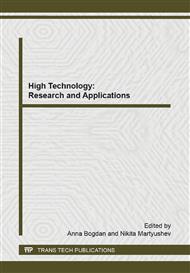[1]
N.A. Ploskov, V.I. Danilov, L.B. Zuev, A.S. Zavodchikov, I.O. Bolotina, D.V. Orlova, Evolution of strain localization autowaves in a zirconium alloy and evaluation of plasticity margin in a rolling area, Journal of Applied Mechanics and Technical Physics. 53 (2012).
DOI: 10.1134/s0021894412040153
Google Scholar
[2]
N.A. Ploskov, V.I. Danilov, L.B. Zuev, I.O. Bolotina, D.V. Orlova, Analysis of the plasticity margin in a rolling site, Russian Physics Journal. 54 (2012) 1389 - 1393.
DOI: 10.1007/s11182-012-9759-8
Google Scholar
[2]
N.V. Martyushev, E.N. Pashkov, Tribotechnical properties lead bronzes, Applied Mechanics and Materials. 379 (2013) 87 - 90.
DOI: 10.4028/www.scientific.net/amm.379.87
Google Scholar
[3]
N.V. Martyushev, E.N. Pashkov, Bronze sealing rings defects and ways of its elimination, Applied Mechanics and Materials. 379 (2013) 82 - 86.
DOI: 10.4028/www.scientific.net/amm.379.82
Google Scholar
[4]
I.G. Vidayev, N.V. Martyushev, A.S. Ivashutenko, A.M. Bogdan, The resource efficiency assessment technique for the foundry production, Advanced Materials Research. 880 (2014) 141 - 145.
DOI: 10.4028/www.scientific.net/amr.880.141
Google Scholar
[5]
I.O. Bolotina, V.I. Danilov, A.A. Zagumennyi, Plastic macrodeformation of polycrystalline and submicrocrystalline titanium for biomedical applications, Journal of Applied Mechanics and Technical Physics. 49 (2008) 484 - 490.
DOI: 10.1007/s10808-008-0065-8
Google Scholar
[6]
T.V. Nekrasova, A.G. Melnikov, N.V. Martyushev, Creation of ceramic nanocomposite material on the basis of ZrO2-Y2O3-Al2O3 with improved operational properties of the working surface, Applied Mechanics and Materials. 379 (2013) 77 - 81.
DOI: 10.4028/www.scientific.net/amm.379.77
Google Scholar
[7]
D. Empl, V. Laporte, E. Vincent, N. Dewobroto, A. Mortensen, Improvement of elevated temperature mechanical properties of Cu–Ni–Sn–Pb alloys, Materials Science and Engineering A. 527 (2010) 4326–4333.
DOI: 10.1016/j.msea.2010.03.056
Google Scholar
[8]
Ugur Ozsarac, Fehim Findik, Mehmet Durman, The wear behaviour investigation of sliding bearings with a designed testing machine, Materials and Design. 28 (2007) 345–350.
DOI: 10.1016/j.matdes.2005.05.017
Google Scholar
[9]
Osmo Teppo, Jaana Niemelä, Pekka Taskinen, The copper-lead phase diagram, Thermochimica Acta. 185, Issue 1 (1991) 155-169.
DOI: 10.1016/0040-6031(91)80126-4
Google Scholar
[10]
I.G. Gorshkov, Molding of ingots of non-ferrous metals and alloys: manual, MetallurgIzdat, Moscow, (1952).
Google Scholar
[11]
N.V. Martyushev, Y.N. Petrenko, Effects of crystallization conditions on lead tin bronze properties, Advanced Materials Research. 880 (2014) 174 - 178.
DOI: 10.4028/www.scientific.net/amr.880.174
Google Scholar
[12]
S. Yu. Tarasov, A.V. Kolubaev, Generation of shear bands in subsurface layers of metals in sliding, Physics of the Solid State. 50 (2008) 844 - 847.
DOI: 10.1134/s1063783408050077
Google Scholar


